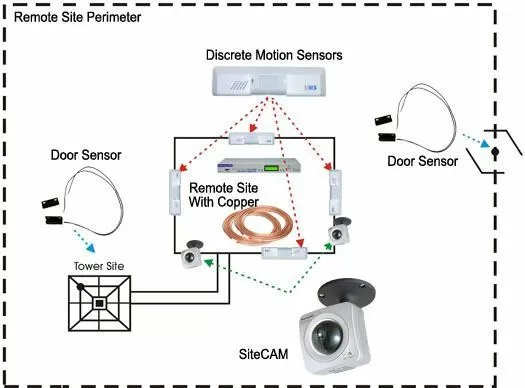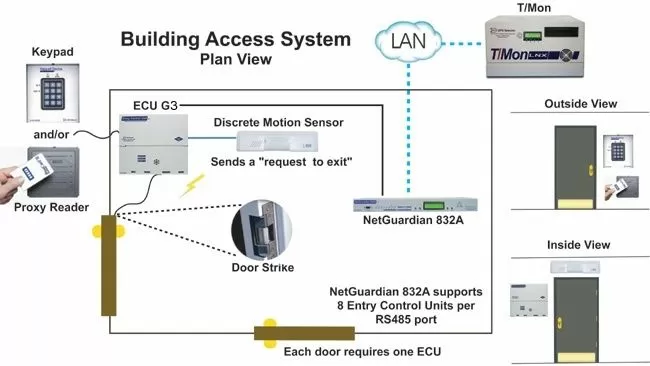Check out our White Paper Series!
A complete library of helpful advice and survival guides for every aspect of system monitoring and control.
1-800-693-0351
Have a specific question? Ask our team of expert engineers and get a specific answer!
Sign up for the next DPS Factory Training!

Whether you're new to our equipment or you've used it for years, DPS factory training is the best way to get more from your monitoring.
Reserve Your Seat TodayAttacks on grid infrastructure seem to be becoming more frequent. Copper theft is a known ongoing headache for any organization with copper wiring or equipment at unmanned sites. Vandals have also become an increased threat to remote infrastructure equipment.
With the threats of vandalism and theft in mind, what can you do to protect your critical infrastructure? Let's go over a few potential reasons for theft and vandalism and measures you can take to combat it.
Environmental monitoring usually makes you think of things like temperature, but the environment around your valuable equipment includes thieves and vandals, too. You must monitor these threats just like you monitor more mundane faults.
Theft, especially copper theft, is a common problem for telecom and utility enterprises. The rate of copper theft changes based on the market price of copper. Depending on the location of your sites and what type of equipment you have unsupervised, theft may be an area of concern for your organization.
COVID-19 has caused financial strain, and increased boredom for many - This may be part of the reason more sites have been targeted (literally).
Many telecom and utility enterprises have had complaints recently of vandals at their remote sites. As I mentioned earlier, we've heard firsthand of a few clients who have had bored hunters shooting at their remote equipment.
I've also seen news stories talking about several similar incidents all over the country, from Alaska to North Carolina. For some reason, there seems to have been an uptick in this type of threat to your vital infrastructure gear.
Vandalism seems to have become a greater nuisance at remote telecom sites. One DPS client, a railroad traveling some of the most rural parts of America, tells us that people have been known to shoot at huts for entertainment. Another of our clients, a power utility in South Carolina, has had similar problems with bored hunters as of late. If your equipment gets shot, it can obviously be extremely dangerous and expensive.

And I don't know whether to laugh or cry about the conspiracy theorists who vandalized several dozen cell towers in the UK because they were convinced that Coronavirus is caused by 5G.
Whatever the motive behind vandalism and theft - be it boredom, conspiracy theories, or financial desperation, the bottom line is: you need to do your best to discourage it from happening.
Remote sites are just that: remote. Unlike at Central Offices, you probably don't have security guards keeping tabs on your equipment in remote locations. So without sufficient security monitoring gear in place, you are blind to the possible threats to your critical equipment.
Consumer-grade monitoring equipment is good for personal and small-scale needs, like home security. But if you're looking to protect infrastructure for telecom, law enforcement, public utility, transportation, or other similarly critical networks, it's just not sufficient. The effects of an interruption to your network uptime is far more disastrous for your organization than, let's say, a raid of your backyard supply shed. The cost of a quality commercial-grade security and monitoring system for your remote sites will likely pay for itself at the first instance of preventing damage or theft.
If you don't have a thorough and solid security and monitoring set-up at your remote site, then anything could happen to your gear. And you wouldn't know about it until your network went down! On top of that, you probably wouldn't be able to tell what the source of the outage was until sending technicians out to the site to see for themselves.
There are a few possible approaches to combating and preventing theft and vandalism at remote sites. Let's talk about a few of them:

Security cameras are the most obvious addition you can make to your substation security system. It's a good idea to have a few cameras monitoring your equipment and the surrounding area. A combination of motion detection and security cameras makes it simple to immediately have eyes on a perimeter intrusion, even as it's happening.
Any camera that outputs contact closure can team up with an RTU (Remote Telemetry Unit) and relay motion alarms. Then you can review security footage from anywhere. The benefits go beyond preventing theft; it would also make you more aware of local wildlife activity and current weather conditions at your sites.
One way to prevent thieves from stealing copper wire is to switch out your copper wiring for glass fiber cable (which is not significantly valuable to thieves) or implement a wireless connection. (Another benefit of this is reduced risk from lightning strikes.) Thieves can't steal copper if there's no copper in your infrastructure to steal. There would be a significant cost involved in making the switch, especially if re-trenching is necessary, but eliminating copper wiring would ease the worry of metal theft.
Another thing that can be done with fiber optics is to string it along fencing. Any touching of fiber cable would cause a change in the signal noise of light shot through it. It's possible to set it up to trigger a physical "motion" alarm.
Posting signs at your remote sites with a message like "Fiber Optic Cable - No Copper" is pretty effective to discourage damage from clueless copper thieves.
Door and motion sensors are simple and effective tools to increase your awareness of activity at remote sites. In addition to alerting you of unexpected activity at your substations, door sensors can help prevent, for example, accidentally leaving doors propped for extended periods of time. Door sensors and motion sensors both go into RTU discrete inputs, which then relay real-time notifications to you if there are any notable events.
Implementing an entry control system at your remote sites is a good idea, particularly if you're concerned about "inside jobs." A good entry control system will allow you to see whether doors are open or closed, locked or unlocked, or propped open (and lock and unlock doors from miles away). A good system would also allow you to instantly grant and revoke access to specific key codes, and view logs of who is accessing the site and when.
One strategy I've seen implemented was to put kevlar curtains up inside the walls at the hut to catch the bullets and protect equipment. One DPS client that was dealing with people frequently shooting at and around their huts improvised this way. A rudimentary solution, maybe, but it might be a worthwhile investment if you're especially concerned about gunshots near your equipment.
Maybe you can think of a DIY deterrent or safeguard that works for your remote locations uniquely. Sometimes a little creativity is all it takes to keep troublemakers away or prevent harm to your equipment.
An alarm master will work together with an RTU at your remote site to relay alarm data from any sensors, security cameras, access control sensors, and any other monitoring devices you have on site. A good alarm master and RTU will relay secure encrypted messages under your choice of a variety of standard security protocols (such as SNMP, Modbus, Syslog).
The T/Mon Remote Alarm Monitoring System is a multiprotocol, multifunction network alarm manager designed as a single-platform solution for all alarm monitoring applications. T/Mon collects alarm data of equipment from numerous manufacturers and protocols. This includes SNMP v3, as required by NERC/FERC standards.
A closed-loop magnetic door sensor will allow you to monitor the status of your doors in real time. You can create settings in your Alarm Master to alert you only after a door has been left open for a certain amount of time. For example, you can customize settings to set a "propped door" alarm if the contact closure has been open for over three minutes.
The discrete Interior/Exterior Motion Sensor uses a combination of passive-infrared and microwave detection with advanced signal processing. It can distinguish between small, repetitive motions such as tree limbs moving in the wind and the more purposeful motions of intruders, thieves, or vandals.
These sensors will relay alarm data (door open or door closed, significant motion detected) to an RTU. The unit will then send real-time notifications to an Alarm Master at your Central Office or to a cell phone or email address. Then you will immediately be alerted of unexpected activity at your remote sites and be able to take immediate action if necessary.
Like I mentioned earlier, using motion sensors in conjunction with surveillance cameras is an effective combination to not only record movement near your critical equipment, but also to know when to look at the live footage. Security cameras are great, but it's a waste of time and manpower to have someone constantly monitoring the footage. The alternative is to miss a critical or suspicious event altogether.
If you saw door and motion alarms in the T/Mon, you could immediately drill down on the map and click the "view camera" icon. That would launch the camera software to view that site's cameras. Icons can be added on your T/Mon maps to any web or software application that you can launch from your computer. Or you can have an icon in the T/Mon WebGFX to open the NVR (video server) for that specific site with a single click and review any detected incident.
In this way you could monitor all the conditions and security devices at your site from one easily maneuverable starting point. The T/Mon allows you to stitch together your preferred interfaces with T/Mon as the top level of oversight.

The Building Access Control System includes a few components: an Entry Control Unit, Keypad or Card Reader, an RTU (like the NetGuardian 832A G6), and a Master Station (like the T/Mon). The BAS has a few very important functions for remote site security.
Firstly, it enables you to create unique user profiles which can be edited remotely. Each access code or key card is connected to a specific user profile, and the BAS sends real-time notifications of approved entries and intrusions. You can grant or deny access by user, day of the week, time of day, and location. That means that, unlike with a physical key, someone could not unlock the door outside of the set hours for that user profile.
The BAS also allows you to remotely lock and unlock doors. This is especially handy if you need to grant access to a maintenance worker, or if one of your technicians didn't bring the right key. It also eliminates the unknown of, "Did I forget to lock the door?"
The BAS integrates building access and security into your existing T/Mon alarm management system. But, it can also function independently of a master if needed.
You'll want to partner with a company with robust monitoring services and a long history in the remote monitoring industry. DPS Telecom is an established remote monitoring company that has been in the telecom security industry for over 37 years. DPS equipment provides tried-and-true solutions to ensure the reliability and protection of your network is maintained.
If you don't see a perfect-fit solution for your network monitoring and security on the market, the DPS team can create a solution that meets your needs. Most existing DPS products only exist because a client asked for it.
Call DPS at (800) 693-0351 or shoot an email to the sales department at sales@dpstele.com for a free-of cost consultation.

Haley Zeigler
Haley is a Technical Marketing Writer at DPS Telecom. She works closely alongside the Sales and Marketing teams, as well as DPS engineers, resulting in a broad understanding of DPS products, clients, and the network monitoring industry.